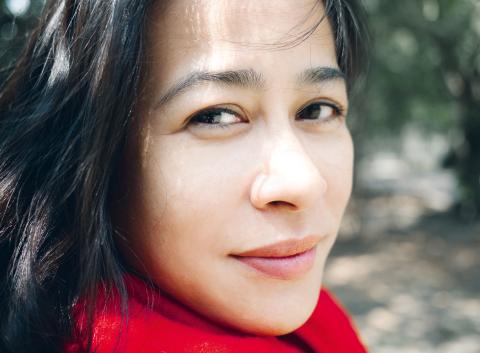For Aboriginal singer/songwriter Ilid Kaolo (以莉‧高露), bossa nova is not merely a music genre — it’s a lifestyle.
Kaolo, who released her debut album My Carefree Life (輕快的生活) to great acclaim last week, will perform two free concerts in Taipei over the next week: at Eslite Xinyi Music Store (信義誠品音樂館) tonight and at Eslite Dunnan Music Store (誠品敦南音樂館) on Wednesday.
Kaolo’s album contains 10 songs she has written over the past decade, six in Amis and four in Mandarin, that blend folk with jazz and bossa nova.

Photo Courtesy of Wind Music
“There are no big theories with my music,” Kaolo told the Taipei Times in a phone interview last week. “I hope it will calm your heart and help you reflect on what you want from life.”
The title track, My Carefree Life, is a laid-back pop gem celebrating a pastoral lifestyle.
“This song is about my memory of the agricultural life in Hualien,” the Amis songstress said. “Watching the breeze blowing at the rice harvest was a wonderful experience.”
In the second single, Charming Eyes (迷人的眼睛), Kaolo uses her sultry, jazzy vocals to encourage modern women to be brave and hold up their heads when facing romantic disillusionment in the urban jungle.
Born in Hualien, Kaolo moved to Taipei at 7 years old and made the city her home for three decades. She started performing with Formosa Aboriginal Song and Dance Troupe (原舞者) in her early 20s and moved on to join the Aboriginal niche label Wild Fire Music (野火樂集) in recent years under the nickname of Hsiao-mei (小美).
In 2006, she joined Hohak Band’s (好客樂隊) agricultural project in Taitung, farming organic rice by day and writing music by night. She returned to her hometown of Hualien last year to continue farming and work on her debut album.
“My life in Taipei was hectic,” Kaolo said. “I went to gigs to perform and had fun with friends and never thought about releasing an album. The farming life allows me to calm my mind and reflect on life. These songs are letters to friends that I wanted to pass on, but never sent.”
As an Aboriginal performer who has experienced the glamorous night life of Taipei and then reclaimed her connection to the earth through farming, Kaolo wants audiences to find peace of mind in her music.
“You can listen to these songs when you want to chill,” she said. “I would be honored if you feel these songs can relax you and ease your loneliness.”

In the March 9 edition of the Taipei Times a piece by Ninon Godefroy ran with the headine “The quiet, gentle rhythm of Taiwan.” It started with the line “Taiwan is a small, humble place. There is no Eiffel Tower, no pyramids — no singular attraction that draws the world’s attention.” I laughed out loud at that. This was out of no disrespect for the author or the piece, which made some interesting analogies and good points about how both Din Tai Fung’s and Taiwan Semiconductor Manufacturing Co’s (TSMC, 台積電) meticulous attention to detail and quality are not quite up to

April 21 to April 27 Hsieh Er’s (謝娥) political fortunes were rising fast after she got out of jail and joined the Chinese Nationalist Party (KMT) in December 1945. Not only did she hold key positions in various committees, she was elected the only woman on the Taipei City Council and headed to Nanjing in 1946 as the sole Taiwanese female representative to the National Constituent Assembly. With the support of first lady Soong May-ling (宋美齡), she started the Taipei Women’s Association and Taiwan Provincial Women’s Association, where she

Chinese Nationalist Party (KMT) Chairman Eric Chu (朱立倫) hatched a bold plan to charge forward and seize the initiative when he held a protest in front of the Taipei City Prosecutors’ Office. Though risky, because illegal, its success would help tackle at least six problems facing both himself and the KMT. What he did not see coming was Taipei Mayor Chiang Wan-an (將萬安) tripping him up out of the gate. In spite of Chu being the most consequential and successful KMT chairman since the early 2010s — arguably saving the party from financial ruin and restoring its electoral viability —

It is one of the more remarkable facts of Taiwan history that it was never occupied or claimed by any of the numerous kingdoms of southern China — Han or otherwise — that lay just across the water from it. None of their brilliant ministers ever discovered that Taiwan was a “core interest” of the state whose annexation was “inevitable.” As Paul Kua notes in an excellent monograph laying out how the Portuguese gave Taiwan the name “Formosa,” the first Europeans to express an interest in occupying Taiwan were the Spanish. Tonio Andrade in his seminal work, How Taiwan Became Chinese,